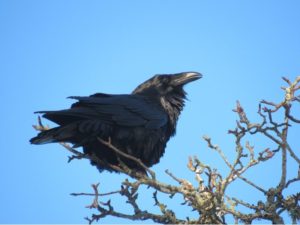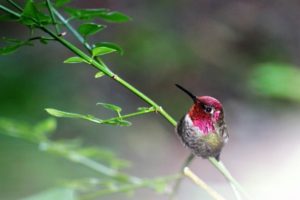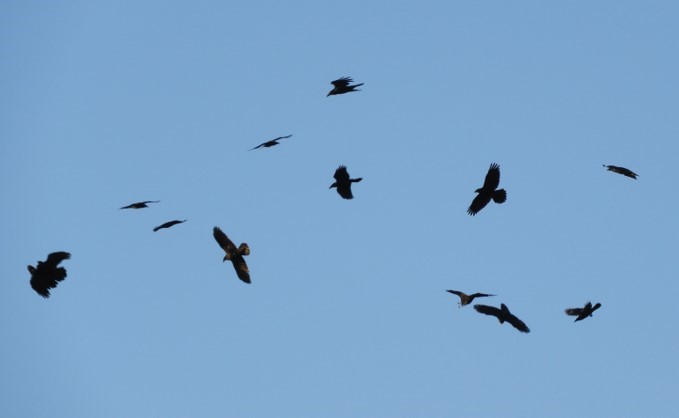
Common Ravens can often be heard chortling and “knocking” in Island Center Forest. A group of ravens may be collectively known as a bazaar, constable, rant, storytelling, or unkindness. Photo by Sherry Lee Bottoms.
As a New Year’s tradition, some birders play a game known as “Bird of the Year,” where the first bird seen/heard in the new year becomes an omen or inspiration for the 12 months ahead. Some pledge to learn all they can about said bird, while others commit to simply noticing it more—observing its habits and appreciating its daily activities. Others explore prophetic meanings and learn of the bird’s cultural and spiritual teachings. I planned to pursue a combination of all three.
As I set out at dawn on Jan. 1 to fill our sadly neglected hummingbird feeder (we’d been out of town), I was looking for my first bird while trying to avoid the ubiquitous crows and starlings, which had taken the starring role in years past. Many birds were making wake-up noises but as I tuned in, I simultaneously heard some Common Ravens greeting the new day just as a Pacific Wren trilled from the underbrush. As I approached the tangled web of honeysuckle vines where the wren was hiding, I held the empty hummingbird feeder at my side. And just as I spied the tiny wren, an Anna’s Hummingbird landed on one of the feeder’s perches—inches from my fingers. The Anna’s sleek green back and cap glistened in the early light and I quietly apologized about the empty feeder as she vainly sought a sip of New Year’s nectar. She flew to the opposite side and poked her beak into another barren feeder flower before flying off, disappointed. As her tiny silhouette zipped off into the ether, I called after her that I would soon deliver brunch.
So, it was decided: raven, wren and hummer would be my birds of 2019! As I filled the feeder with sugar water, I savored the possibilities, pleased with my first birds.
It’s easier to find musings about ravens and hummingbirds than wrens. I started with my Medicine Cards (Sams and Carson)—a collection featuring animals and their teachings drawn from Native American beliefs about animal medicine—that which “improves ones’ connection to the Great Mystery and to all life.”
The Medicine Cards equate raven with magic and include this inspiring passage: “Raven magic is a powerful medicine that can bring you the courage to enter the darkness of the void, which is the home of all that is not yet in form … Raven is a messenger from the void. If raven appears … you are about to experience a change in consciousness.” A perfect New Year’s prophesy—bring it on!
Just watching these intelligent birds can spur expanded awareness. Members of the brilliant corvid family, Common Raven (Corvus corax) is known for her playful nature and acute intelligence. One day I was lucky enough to witness a raven literally somersaulting though the air, and another time I saw a group of them seemingly gather to watch—or even take part in—an outdoor performance at the Open Space.

This male Anna’s Hummingbird has an iridescent head and gorget (throat patch) with brilliant colors that are not due to pigment but thanks to microscopic structural features on the feather surface. Photo by Sherry Lee Bottoms.
My next bird was the hummer and I wasn’t surprised to learn that their medicine is joy. Her animal card reads: “Follow Sister Hummingbird and you will soon be filed with paroxysm of joy, and experience a renewal of the magic of living.” Paroxysms!? I’ll take it. Thanks, Anna’s!
I think a hummingbird’s daily exuberance must be partly borne of deeply powerful dreams. An Anna’s heart beats an astounding 1,260 times a minute in daytime, but it slows to just 50 beats per minute at night. Going into a nightly state of torpor allows the birds to conserve energy—a necessary feat considering their fast-paced daily routine requires them to swallow their weight in food every day! Each morning before dawn, a hummer’s inner alarm clock spurs it awake so it can begin round after round of nectar seeking and insect gathering.
This time of year in the Pacific Northwest, some Anna’s Hummingbirds (Calypte Anna) are beginning to nest. So along with collecting tiny insects out of spider’s webs to eat (they also catch insect prey on the wing in a behavior called “hawking” and enjoy insects caught in tree sap) you may also see them gathering spider silk to bind together their plum-sized cup nests painstakingly formed of lichen, cattail down and other plant fibers.
In searching for wrens in local Native American lore I only found a warring wren from Idaho, so I typed in “wren mythology” and found the White Goddess Pagan Portal, which offers a flock of wren stories, of which I was drawn to the least blood-thirsty:
“The wren has always been a King as its name in European languages indicates:

Follow the Pacific Wren’s long, bubbling song to find their dark forest hideaways. Photo by Sherry Lee Bottoms.
Latin, Regulus; French, Reytelet; Welsh, dryw, king; Teutonic, Koning Vogel, king-bird; Dutch, Konije, little, king. In Manx, Dreain, from druai dryw, the Druid’s bird.”
Pacific Wrens (Troglodytes pacificus) are mouse-like birds in both their size and habit of scurrying about the forest floor. It’s common to see only the quivering twig he bird has just brushed past rather than the wren himself. They have one of the longest and most complex songs of any bird—a delightful tumbling aria that is a quintessential voice of our deep-green forests. Males sing for up to 10 seconds and can connect 50 musical verses!
I especially resonated with the following wren tale that serendipitously happened on New Year’s Day and reflects the fact that it can be challenging to locate a wily Pacific Wren in its forest hideout: “The wren symbolised wisdom and divinity. It is difficult to actually see a wren. At New Year it is said that the apprentice Druid would go out by himself into the countryside in search of hidden wisdom. If he found a wren he would take that as a sign that he would be blessed with inner knowledge in the coming year. Finding a creature small and elusive to the point of invisibility was a metaphor for finding the elusive divinity within all life.”
So, magic, joy and inner-knowledge! That’s a keeper trifecta. At the very least, I will pay special homage to these avian friends in the coming year.
There are no hard and fast rules to this game, so you can find your own first bird anytime you choose, though I think it’s most fun to set out with this intent in mind and accept whatever bird appears first.
Happy New Year and here’s to you finding your own feathered emissaries!
A very special thanks to photographer Sherry Lee Bottoms for supplying the beautiful images for this post, including the “rant” of ravens in the header.


Wilson’s Snipe at Fisher Pond was my 2019 new year bird. And a first for me. What a great idea to pay special attention to this long-billed shorebird. Thank you Katherine and the fabulous Vashon Nature Center!
Thanks for posting, Julie! That’s an awesome first bird! I’ve found that my firsts keep appearing in my life. Hope that’s the same for you and the snipe.